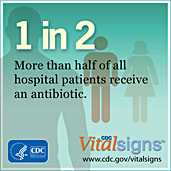| Reference |
Setting |
Key staff |
Intervention |
Impact |
| Valiquette L, Cossette B, Garant MP, Diab H, Pepin J, Impact of a Reduction in the Use of High-Risk Antibiotics on the Course of an Epidemic of Clostridium Difficile-Associated Disease Caused by the Hypervirulent NAP1/027 Strain. CID 2007:45 (Suppl 2) S112-S121 |
683-bed, secondary/tertiary-care hospital, Sherbooke, Quebec, Canada |
infectious disease physicians, pharmacists, infection control |
Guidelines for decreasing antibiotics use associated with Clostridium difficile infections – Creation of educational materials for physicians and pharmacists. Created recommendations to suggest alternative antibiotics for treating conditions. Recommended shorter treatment duration for certain conditions based on Infectious Disease Society of America’s guidelines. |
C. diff incidence decreased 60% between 2003-2004 and 2005-2006, total and targeted antibiotic consumption decreased 23% and 54% respectively. Decrease in use of 1st generation cephalosoprins (21%), 2nd generation cephalosporins (93%), 3rd generation cephalosporins (79%), clindamycin (87%), macrolides (78%), and ciprofloxacin (29%). Increase in use of respiratory fluoroquinolones (79%) and pip/tazo (114%) between 2003-2004 and 2005-2006. |
| Muto CA, Blank MK, Marsh, JW, Vergis EN, O'Leary MM, Shutt KA, Pasculle AW, Pokrywka M, Garcia JG, Posey K, Roberts, TL, Potoski BA, Blank GE, Simmons RL, Veldkamp P, Harrison LH, Pateron DL. Control of an Outbreak of an Infection with the Hypervirulent Clostridium difficile BI strain in a unversity hospital using a comprehensive "bundle" approach. CID 2007, 45: 1266-1273 |
834-bed, tertiary-care urban teaching hospital, Pittsburgh, PA, USA |
infectious disease physicians |
Creation of educational materials for providers, establishment of active surveillance for C. diff, expanded infection control measures with infection control audits (i.e. observing handwashing trends), targeted antimicrobial restriction whereby clindamycin, ceftriaxone, levofloxacin and other broad-spectrum antibiotics required ID and pharmacist approval. |
Antimicrobial therapy associated with C. diff infections decreased by 41% from 2003-2005 (clindamycin by 69% and fluoroquinolones by 54%. Aggregate rate of C. diff infections decreased from 7.2 per 1000 discharges to 4.8 per 1000 from 2001-2006 and was 3 per 1000 by 2006. |
| Fowler S, Webber A, Cooper BS, Phimister A, Price K, Carter Y, Kibbler CC, Simpson AJH, Stone SP. Successful use of feedback to improve antibiotic prescribing and reduce Clostridium difficile infection: a controlled interrupted time series. Journal of Antimicrobial Chemotherapy (2007), 59: 990-995 |
1200-bed, teriary-care teaching hospital (intervention acute care geriatric wards, 78 beds), London, UK |
infection control doctor, infection control nurse |
Narrow-spectrum antibiotic policy: recommedations for reduction in amox/clavulanate and cephalosporin use and increased use of benzyl penicillin, trimethoprim and amoxicillin, physicians given individual antibiotic feedback and information on C. diff and MRSA infection rates every 8-12 weeks |
Significant reduction in amox/clavulanate and cephalosporins use at time of intervention and after intervention. Significant increase in long-term benzyl penicillin use. A sudden change in amoxicillin. Decrease in C. diff infections (IRR 0.35 (0.17,0.73),) but no changes in MRSA (0.79 (0.49, 1.28)). |
| Carling P, Fung T, Killion A, Terrin N, and Barza M. Favorable impact of a multidisciplinary antiobiotic management program conducted during 7 years. Infection Control and Hospital Epidemiology. 2003;24(9): 699-706 |
174-bed, university-affliated community teaching hospital, Boston, MA, USA |
infectious disease physician and clinical pharmacist |
Multidisciplinary-prospective antibiotic monitoring to provide individualized therapeutic recommendations, specific emphasis on inappropriate use parenteral antibiotics, program uses guidelines, pharmacy restrictions and antibiotics detailing with individual prescriber education. |
22% decrease in the use of parenteral broad-spectrum abx use (p<0.0001) despite 15% increase in acuity of patients care over 7 years. Decrease in incidence of C. diff from 2.2 cases per 1,000 patient days to 1.4 cases per 1,000 patient days (p=0.002). Similar trend in decreasing in resistant enterobacteriaceae causing nosocomial infections (p=0.002). No changes in MRSA rates. |




 ShareCompartir
ShareCompartir